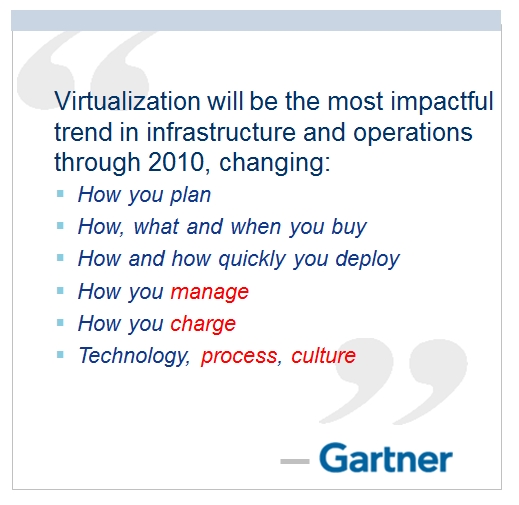Our journey into the virtual world
Virtual Machines, or simply, VMs—who doesn't know what they are? Even a business user who has never seen one knows what it is. It is just a physical server, virtualized—nothing more.
Wise men say that small leaks sink the ship. I think that's a good way to explain why IT departments that manage physical servers well struggle when the same servers are virtualized.
We can also use the Pareto principle (80/20 rule): 80 percent of a VM is identical to a physical server. But it's the 20 percent of differences that hits you. We will highlight some of this 20 percent portion, focusing on areas that impact data center management.
The change caused by virtualization is much larger than the changes brought about by previous technologies. In the past two or more decades, we transitioned from mainframes to the client/server-based model and then to the web-based model. These are commonly agreed upon as the main evolutions in IT architecture. However, all of these are just technological changes. They changed the architecture, yes, but they did not change the operation in a fundamental way. Both the client-server and web shifts did not talk about the "journey". There was no journey to the client-server based model. However, with virtualization, we talk about the virtualization journey. It is a journey because the changes are massive and involve a lot of people.
Gartner correctly predicted the impact of virtualization in 2007 (http://www.gartner.com/newsroom/id/505040). More than 8 years later, we are still in the midst of the journey. Proving how pervasive the change is, here is the summary of the article from Gartner:

Notice how Gartner talks about a change in culture. So, virtualization has a cultural impact too. In fact, if your virtualization journey is not fast enough, look at your organization's structure and culture. Have you broken the silos? Do you empower your people to take risks and do things that have never been done before? Are you willing to flatten the organizational chart?
Note
The silos that have served you well are likely your number one barrier to a hybrid cloud.
So why exactly is virtualization causing such a fundamental shift? To understand this, we need to go back to the basics, which is exactly what virtualization is. It's pretty common that chief information officers (CIOs) have a misconception about what it is.
Take a look at the following comments. Have you seen them in your organization?
VM is just a physical machine that has been virtualized. Even VMware says the Guest OS is not aware it's virtualized and it does not run differently.
It is still about monitoring CPU, RAM, disk, network, and other resources—no difference.
It is a technological change. Our management process does not have to change.
All of these VMs must still feed into our main enterprise IT management system. This is how we have run our business for decades, and it works.
If only life were that simple; we would all be 100-percent virtualized and have no headaches! Virtualization has been around for years, and yet, most organizations have not mastered it. The proof of mastering it is if you complete the journey and reach the highest level of the virtualization maturity model.

























































